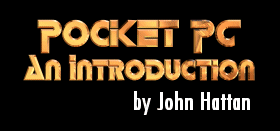11/10 - 11/12 @ Montréal, Canada
12/5 - 12/7 @ Shanghai, China
12/24 - 12/27
2/28 - 3/4 @ San Francisco, CA
More events...
2406 articles in the reference section.
Help us fight cancer!
Join SETI Team GDNet!

|
Windows CE is a monsterous mess, and it's frighteningly difficult to use If you've been reading the trade articles of the past few years, this is probably the impression you got from Microsoft's handheld entries. There are some facts, though, that you might not know. . .
This article is going to explore what exactly is Windows CE, what this PocketPC thing is, some of the technical aspects that make it the finest platform for handheld gaming available today, and how to get started developing for one. What is Windows CE and What is PocketPC?BackgroundUnlike Microsoft's previous efforts at ROM-able Windows, Windows CE is a ground-up rewrite. While it may look more or less like plain old Windows , it is a completely different animal from Windows 3.x, Windows 9x, and Windows NT. The designers of CE decided early on to focus on portability and small size in the design of CE, and it shows. Making a truly tiny machine based on a Pentium-class processor just wouldn't be practical, because even though there are low-power Pentium-class processors for laptops, shrinking a Pentium machine to the size of a deck of cards and still getting reasonable battery life just wasn't going to happen. Hence, Windows CE was written to work with for alternative processors with very low power consumption, like the StrongARM, SH3/SH4, and MIPS. Thankfully, though, you don't have to worry about what processor for which you're writing. Much like Microsoft's unsuccessful plans for Windows NT running on every desktop platform, you can write to a standard Windows API and get your application to work on all CE processors with a simple recompile. . . .and this time, it actually works. DevicesWhile Windows CE is not locked into any particular form-factor and is capable of running on anything from embedded microcontrollers to cell-phones, two main form-factors have become predominant, the Handheld PC and the PocketPC. Handheld PC 2000This version should look instantly familiar. It looks and acts very similarly to the Windows you've come to know and tolerate.
The only major difference is that the applications don't live in nice little overlapping panes. Since the screen is so small, apps automatically grow to the size of the screen, and the title and menubars are combined. Here's what the baby version of Excel looks like on the same machine.
The market for Handheld PC's based on Windows CE unfortunately is in decline. While the platform started strongly a few years ago with high-quality offerings like the Philips Velo, HP Jornada, Sharp Mobilon, and Vadem Clio, only the HP has survived until the release of MS's Handheld PC 2000 software. PocketPCIn response to the instant success of the Palm Computing platforms, Microsoft intruduced the Palm-size PC. Like the Handheld PC, it started out with several vendors, many of which bailed after low sales, like Uniden and Philips. Despite the technical superiority of hardware like the Casio E-100 series, the Palm-size PC platform was savaged by critics for being overcomplicated and clumsy to use. The standard Windows interface, while it worked well on larger screens, was tight on Handhelds and was downright difficult on a small 240x320 screen.
About a year ago, Microsoft released a new version of the Windows CE interface, redubbed "PocketPC". While internally it was basically the same Windows CE as the earlier versions, the user-interface was retooled to work better on a tiny screen. The start menu was moved to a little icon in the corner. The menubar shrank and moved to the bottom. It took very good advantage of color. Best of all, Microsoft finally made available the baby-office apps that had previously only been available on the Handheld PC's. Critics, on the whole, have been warm to the changes, finding the interface faster and easier to use.
|